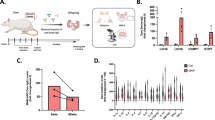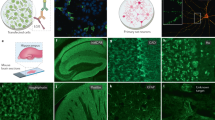Abstract
Systemic lupus erythematosus (SLE) is an autoimmune disease mediated by autoantibodies and preferentially affecting women of childbearing age. Because the offspring of mothers with SLE show a high frequency of learning disorders1,2,3,4,5, we hypothesized that maternally transferred autoantibodies that bind DNA and the N-methyl-D-aspartate receptor (NMDAR)6,7,8,9,10,11,12 could have a pathogenic role during fetal brain development. Here we describe a maternal SLE mouse model wherein pregnant dams harbored DNA-specific, NMDAR-specific autoantibodies throughout gestation. High titers of these autoantibodies in maternal circulation led to histological abnormalities in fetal brain and subsequent cognitive impairments in adult offspring. These data support a paradigm in which in utero exposure to neurotoxic autoantibodies causes abnormal brain development with long-term consequences. This paradigm may apply to multiple congenital neuropsychiatric disorders.
This is a preview of subscription content, access via your institution
Access options
Subscribe to this journal
Receive 12 print issues and online access
$209.00 per year
only $17.42 per issue
Buy this article
- Purchase on Springer Link
- Instant access to full article PDF
Prices may be subject to local taxes which are calculated during checkout




Similar content being viewed by others
References
Lahita, R.G. Systemic lupus erythematosus: learning disability in the male offspring of female patients and relationship to laterality. Psychoneuroendocrinology 13, 385–396 (1988).
McAllister, D.L. et al. The influence of systemic lupus erythematosus on fetal development: cognitive, behavioral, and health trends. J. Int. Neuropsychol. Soc. 3, 370–376 (1997).
Neri, F. et al. Neuropsychological development of children born to patients with systemic lupus erythematosus. Lupus 13, 805–811 (2004).
Ross, G., Sammaritano, L., Nass, R. & Lockshin, M. Effects of mothers' autoimmune disease during pregnancy on learning disabilities and hand preference in their children. Arch. Pediatr. Adolesc. Med. 157, 397–402 (2003).
Tincani, A. et al. Impact of in utero environment on the offspring of lupus patients. Lupus 15, 801–807 (2006).
DeGiorgio, L.A. et al. A subset of lupus anti-DNA antibodies cross-reacts with the NR2 glutamate receptor in systemic lupus erythematosus. Nat. Med. 7, 1189–1193 (2001).
Kowal, C. et al. Human lupus autoantibodies against NMDA receptors mediate cognitive impairment. Proc. Natl. Acad. Sci. USA 103, 19854–19859 (2006).
Yoshio, T., Onda, K., Nara, H. & Minota, S. Association of IgG anti-NR2 glutamate receptor antibodies in cerebrospinal fluid with neuropsychiatric systemic lupus erythematosus. Arthritis Rheum. 54, 675–678 (2006).
Omdal, R. et al. Neuropsychiatric disturbances in SLE are associated with antibodies against NMDA receptors. Eur. J. Neurol. 12, 392–398 (2005).
Lapteva, L. et al. Anti–N-methyl-d-aspartate receptor antibodies, cognitive dysfunction and depression in systemic lupus erythematosus. Arthritis Rheum. 54, 2505–2514 (2006).
Husebye, E.S. et al. Autoantibodies to a NR2A peptide of the glutamate/NMDA receptor in sera of patients with systemic lupus erythematosus. Ann. Rheum. Dis. 64, 1210–1213 (2005).
Steup-Beekman, G.M., Steens, S.C., van Buchem, M.A. & Huizinga, T.W. Anti-NMDA receptor autoantibodies in patients with systemic lupus erythematosus and their first-degree relatives. Lupus 16, 329–334 (2007).
Hanly, J.G. New insights into central nervous system lupus: a clinical perspective. Curr. Rheumatol. Rep. 9, 116–124 (2007).
Fragoso-Loyo, H. et al. Serum and cerebrospinal fluid autoantibodies in patients with neuropsychiatric lupus erythematosus. Implications for diagnosis and pathogenesis. PLoS ONE published online 6 Oct., doi:10.1371/journal.pone.0003347.
Kowal, C. et al. Cognition and immunity; antibody impairs memory. Immunity 21, 179–188 (2004).
Huerta, P.T., Kowal, C., DeGiorgio, L.A., Volpe, B.T. & Diamond, B. Immunity and behavior: antibodies alter emotion. Proc. Natl. Acad. Sci. USA 103, 678–683 (2006).
Morphis, L.G. & Gitlin, D. Maturation of the maternofoetal transport system for human γ-globulin in the mouse. Nature 228, 573 (1970).
Buyon, J.P. & Clancy, R.M. Neonatal lupus syndromes. Curr. Opin. Rheumatol. 15, 535–541 (2003).
Putterman, C. & Diamond, B. Immunization with a peptide surrogate for double-stranded DNA (dsDNA) induces autoantibody production and renal immunoglobulin deposition. J. Exp. Med. 188, 29–38 (1998).
Hanashima, C. et al. Brain factor-1 controls the proliferation and differentiation of neocortical progenitor cells through independent mechanisms. J. Neurosci. 22, 6526–6536 (2002).
Kriegstein, A.R. & Noctor, S.C. Patterns of neuronal migration in the embryonic cortex. Trends Neurosci. 27, 392–399 (2004).
Zhang, J. et al. Identification of DNA-reactive B cells in patients with systemic lupus erythematosus. J. Immunol. Methods 338, 79–84 (2008).
Rafael, J.A., Nitta, Y., Peters, J. & Davies, K.E. Testing of SHIRPA, a mouse phenotypic assessment protocol, on Dmd(mdx) and Dmd(mdx3cv) dystrophin-deficient mice. Mamm. Genome 11, 725–728 (2000).
Ten, V.S., Bradley-Moore, M., Gingrich, J.A., Stark, R.I. & Pinsky, D.J. Brain injury and neurofunctional deficit in neonatal mice with hypoxic-ischemic encephalopathy. Behav. Brain Res. 145, 209–219 (2003).
Lubics, A. et al. Neurological reflexes and early motor behavior in rats subjected to neonatal hypoxic-ischemic injury. Behav. Brain Res. 157, 157–165 (2005).
Quirk, G.J., Garcia, R. & González-Lima, F. Prefrontal mechanisms in extinction of conditioned fear. Biol. Psychiatry 60, 337–343 (2006).
Barker, G.R. et al. The different effects on recognition memory of perirhinal kainate and NMDA glutamate receptor antagonism: implications for underlying plasticity mechanisms. J. Neurosci. 26, 3561–3566 (2006).
Goodrich-Hunsaker, N.J., Hunsaker, M.R. & Kesner, R.P. Dissociating the role of the parietal cortex and dorsal hippocampus for spatial information processing. Behav. Neurosci. 119, 1307–1315 (2005).
Verkhratsky, A. & Kirchhoff, F. NMDA receptors in glia. Neuroscientist 13, 28–37 (2007).
Salter, M.G. & Fern, R. NMDA receptors are expressed in developing oligodendrocyte processes and mediate injury. Nature 438, 1167–1171 (2005).
Manent, J.B. et al. A noncanonical release of GABA and glutamate modulates neuronal migration. J. Neurosci. 25, 4755–4765 (2005).
van Zundert, B., Yoshii, A. & Constantine-Paton, M. Receptor compartmentalization and trafficking at glutamate synapses: a developmental proposal. Trends Neurosci. 27, 428–437 (2004).
Ritter, L.M., Unis, A.S. & Meador-Woodruff, J.H. Ontogeny of ionotropic glutamate receptor expression in human fetal brain. Brain Res. Dev. Brain Res. 127, 123–133 (2001).
Shi, L., Fatemi, S.H., Sidwell, R.W. & Patterson, P.H. Maternal influenza infection causes marked behavioral and pharmacological changes in the offspring. J. Neurosci. 23, 297–302 (2003).
Dalton, P. et al. Maternal neuronal antibodies associated with autism and a language disorder. Ann. Neurol. 53, 533–537 (2003).
Martin, L.A. et al. Stereotypies and hyperactivity in rhesus monkeys exposed to IgG from mothers of children with autism. Brain Behav. Immun. 22, 806–816 (2008).
Galaburda, A.M., Sherman, G.F., Rosen, G.D., Aboitiz, F. & Geschwind, N. Developmental dyslexia: four consecutive patients with cortical anomalies. Ann. Neurol. 18, 222–233 (1985).
Walsh, C.A. Genetic malformations of the human cerebral cortex. Neuron 23, 19–29 (1999).
Newman, J., Rice, J.S., Wang, C., Harris, S.L. & Diamond, B. Identification of an antigen-specific B cell population. J. Immunol. Methods 272, 177–187 (2003).
Wardemann, H. et al. Predominant autoantibody production by early human B cell precursors. Science 301, 1374–1377 (2003).
Acknowledgements
The work was supported by grants from the US National Institutes of Health (B.D., P.T.H. and B.T.V.) and the Alliance for Lupus Research (B.T.V.). We are grateful to L. DeGiorgio, S. Loncar, T. Huerta and R. Berlin for technical assistance; M. Scharff, E. Chang and T. Faust for suggestions on the manuscript; and S. Jones for help in preparing the manuscript.
Author information
Authors and Affiliations
Contributions
J.Y.L. initiated this project, performed the studies of histology in E15 mice and analyzed negative geotaxis in newborn pups. P.T.H. performed all of the behavioral analyses. J.Z. generated the human monoclonal antibodies. C.K. performed all of the studies of antibody transfer to fetal brain and participated in several studies of antibody titers in immunized mice. E.B. performed the studies of immunohistology with monoclonal antibodies and peptide inhibition. B.T.V. contributed to the design of the study and performed histological analyses of adult brain. B.D. participated in the design of the studies. All authors contributed to data analysis.
Corresponding author
Supplementary information
Supplementary Text and Figures
Supplementary Figs. 1–6 and Supplementary Table 1 (PDF 816 kb)
Rights and permissions
About this article
Cite this article
Lee, J., Huerta, P., Zhang, J. et al. Neurotoxic autoantibodies mediate congenital cortical impairment of offspring in maternal lupus. Nat Med 15, 91–96 (2009). https://doi.org/10.1038/nm.1892
Received:
Accepted:
Published:
Issue Date:
DOI: https://doi.org/10.1038/nm.1892
This article is cited by
-
Maternal brain reactive antibodies profile in autism spectrum disorder: an update
Translational Psychiatry (2023)
-
A nationwide study of the risks of major mental disorders among the offspring of parents with rheumatoid arthritis
Scientific Reports (2022)
-
Risk assessment analysis for maternal autoantibody-related autism (MAR-ASD): a subtype of autism
Molecular Psychiatry (2021)
-
Autoantibodies in neurological disease
Nature Reviews Immunology (2021)
-
Cognitive Impairment in SLE: Mechanisms and Therapeutic Approaches
Current Rheumatology Reports (2021)



